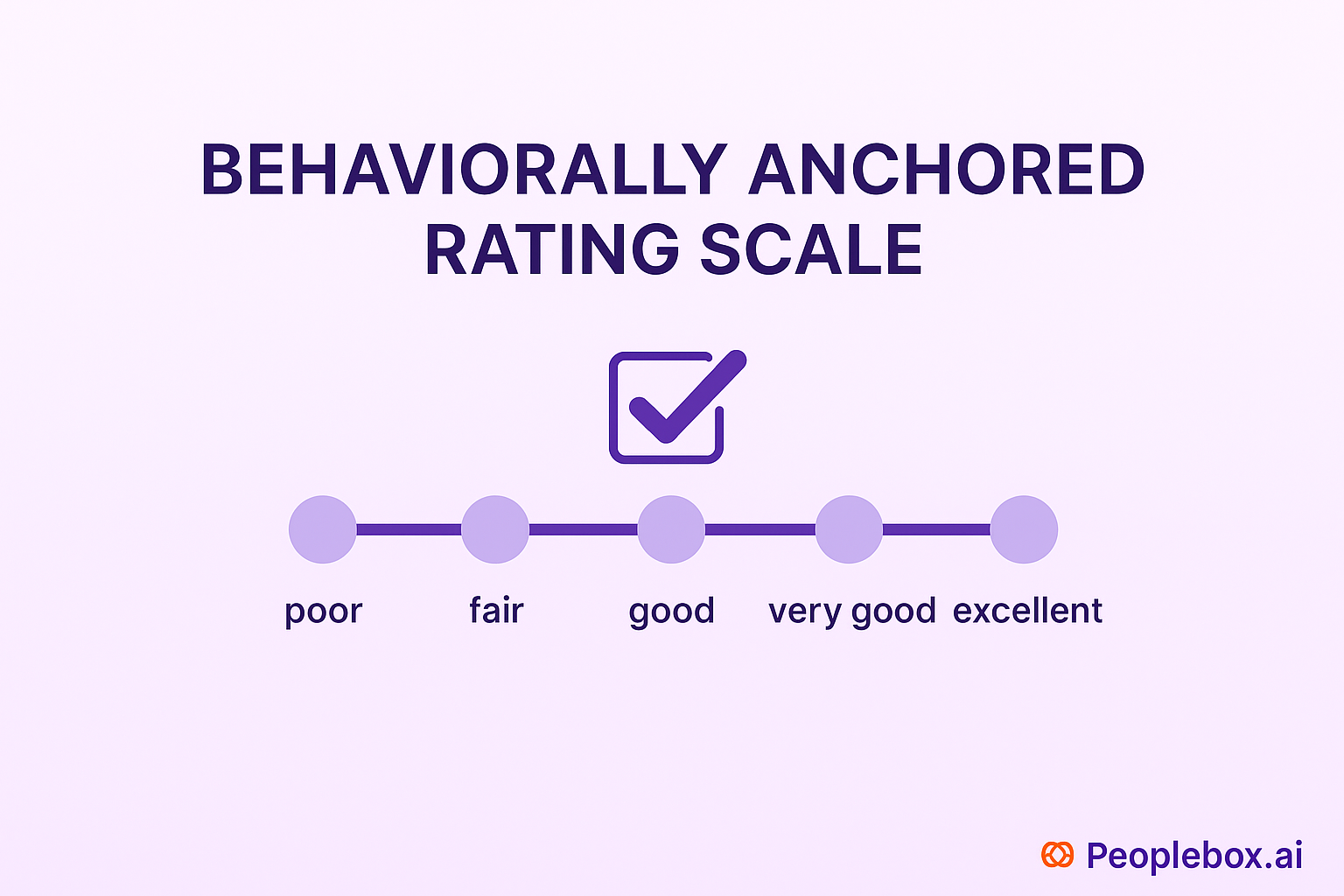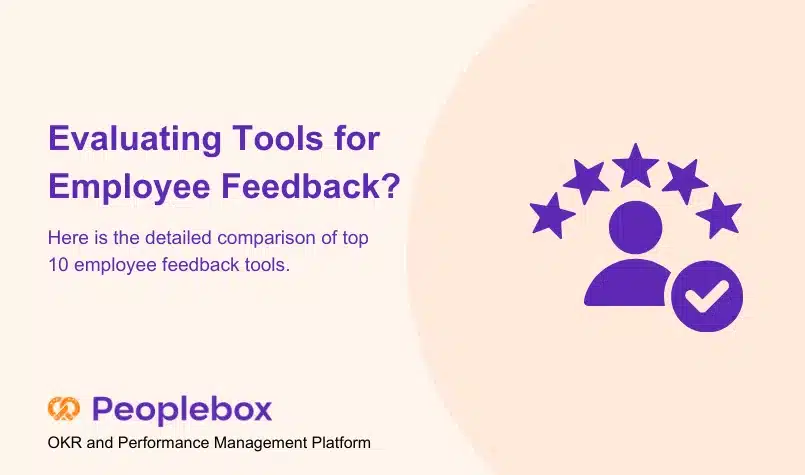TL;DR
BARS (Behaviorally Anchored Rating Scale) is a performance management tool that helps companies measure employee performance objectively by linking specific behaviors to rating scales. It ensures fairness, consistency, and clarity during evaluations.
BARS aids in enhancing employee performance, providing actionable feedback, and boosting retention. It’s ideal for companies aiming for more growth-oriented and transparent performance reviews.
The Behaviorally Anchored Rating Scale, or BARS, offers a better way for groups to check how well people are doing at work. It mixes watching what people do with clear ways to measure their work, so reviews become more helpful.
Instead of simple rating scales, BARS looks at specific actions that show how well someone does their job at any level. This makes reviews easier to grasp and more equitable. It joins what folks do on the job with how they are rated, ensuring everyone understands where they stand.
Many places use BARS to make sure their reviews are consistent and fair, cutting down on unfair scoring. Whether you want your team to work better or you’re in HR searching for better ways to check on things, knowing about BARS can change how you rate worker performance.
What is BARS?
BARS is a method of measuring how well people do their jobs. It focuses on the actions they take. It uses detailed descriptions and scores to rate workers. It stands apart from other scales because it uses actual examples and clear descriptions.
BARS came about in the 1960s to make reviews less about personal feelings. It links each score to real things people do on the job. If rating teamwork, for example, instead of just giving a score, BARS would use actions. Something like, Works well with others to tackle tough problems, using each person’s talents, would earn a higher rating.
BARS is a solid pick because it’s precise and fits with what the company is trying to do. Compared to old ways, BARS brings a lot to the table: it’s more fair, gives helpful comments, and lines up with company aims.
Key Components of BARS
There are several parts of BARS that together make it a good choice for checking up on how people are doing:
1. Anchored Behaviors:
These are actions that show different levels of doing a job. These are chosen carefully to match the job needs and give clear ways to rate performance.
For instance, with a salesperson, activities might always beat sales goals and keep good ties with customers for high performance. On the lower end, it might be, Has trouble hitting basic sales goals, even after extra help.
2. Rating Scale:
It uses both numbers and descriptions. What sets it apart from common scales, where numbers might be unclear, is that each dot on a BARS scale is connected to certain actions. Ratings become more clear and the same across the board.
3. Critical Incidents:
These are real-life examples of things workers have done that either improved or hurt their work. Teams get these from talking with workers, doing discussions with them, or watching them on the job. This brings realness and relevance to the BARS scale.
4. Teamwork:
A big part of BARS is that it’s built with thoughts from HR, bosses, and employees. This makes the scale more correct. Workers are more likely to trust the review process. It also makes sure the scale syncs with the company’s targets and is just in its judgments.
When these parts come together, BARS becomes a solid tool for fair and fact-based reviews. This helps workers get better and the company does better.
How BARS Work: The Process Explained
BARS has a system to keep reviews on point and correct:
1. Find Key Responsibilities:
Begin by finding the main duties people have at their jobs. This means deciding what success is for each job. This includes hitting sales marks, keeping quality high, or giving great customer help.
2. Gather Critical Incidents:
You need to get examples of things workers did well or poorly related to each duty. So, talk to workers, managers, and others to get these examples.
For a project leader, an example of doing well might be, Led a team to beat the deadline on a project. Doing poorly might look like, Did not tell people about changes, which caused confusion and delays.
3. Make Behavior Dimensions:
After you have the incidents, HR and managers team up to make behavior anchors for the ranking scale. These anchors tell what actions go with each level of doing a job from best to worst.
4. Put the Rating Scale Together:
The finished scale is used during reviews. Managers rate workers based on the actions laid out. This keeps reviews equal and based on standards everyone can see.Workers get comments based on their scores, along with ways to get better.
By going through these steps, BARS lets companies do reviews that are fair, easy to get, and aimed at helping folks grow. Both workers and the place they work see rewards.
Advantages of Using BARS
BARS has many upsides that make it a good pick for looking at work performance:
1. Enhanced Objectivity
One of the best parts is that it makes reviews more fact-based. By joining scores to actions, BARS turns down bias. It makes reviews the same from boss to boss and from area to area.
2. Consistency Across Evaluators
BARS sends a clear message on what’s wanted from workers all across the board. Each score ties to certain actions. Workers know just what they need to do to get high scores. This nudges them to think about doing what the company wants.
3. Comments are Better:
BARS makes comments more in-depth. Bosses can give clear examples using the behavior anchors. This makes the feedback more useful. Bosses can then guide workers better.
4. Workers Get On Board:
When workers get to help make BARS, they will likely trust the method and get involved. Letting them help set key moments and behavior anchors makes the method seem more fair and current.
5. Fair to the Law:
BARS works off job-tied actions, which makes it easier to back up in court. This cuts the risk of claims of leaning a certain way or reviewing fights. The focus on actions brings papers that show why choices on performance were made.
6. Focus on Growth:
Instead of just ranking workers, BARS guides on how to step up your game. This lines up with plans for running performance now. The aim is on growth, not just judging.
These good things make BARS a worthwhile tool for checking on performance. Especially if it’s used with a system that guides on how to set it up and keep it going.
Limitations and Challenges of BARS
While BARS brings a lot to the table, there are limits and hard parts companies need to note:
1. Takes Time:
Setting up a BARS setup takes effort. You need to pinpoint key times, make action anchors, and ensure the scale works across jobs.
2. Not Easy to Shift:
BARS walks a set path that can be hard to step off once you begin. The actions that are laid out can make it hard to judge workers in jobs that are always changing. This hits hard in quick-moving fields.
3. Feelings Can Creep In:
Picking turning points and behavior anchors can be about feelings. Even though the review is fact-based, the folks who make the scale can let biases in.
4. Rough to Judge New Ideas:
BARS might not be great at jobs needing new ideas or thought-out problem-solving. It centers on set actions over finding new ways.
5. Training Needed:
Bosses need training to put BARS into action and give comments using action-based studying.
6. Must Stay Up To Date:
BARS needs to be checked and changed often to fit new job duties. This means work on HR’s end.
Knowing these bumps is key to getting the most out of BARS when checking on performance.
Tips for Effective Implementation of BARS
If you’re looking to make BARS work well, you need to think and go through with it with care. Here are pointers to winning:
1. Get Everyone In:
Be sure staff, bosses, and HR come together. Work on naming key moments and defining behavior anchors. This makes the system current and seen as okay by those it touches.
2. Plan Training:
Bosses need whole training to get how to use the scale and give helpful feedback based on what they see. Rules that are easy to get plus examples can turn away problems.
3. Begin Not Too Big:
Give BARS a try with a small group. Or roll it out in just one area to test it and find problems. Then, change it based on feedback.
4. Watch and Change:
Job facts will change. You should check and change key moments and action anchors often. This will all improve the system.
5. Blend With Other Systems:
Join BARS with more performance tools. This looks like target-setting spots and plans for how to learn new things. You’ll get more from these behavior-based checks.
6. Speak Clear:
Speak on the point of BARS, how it works, and what good it does to all who will use it. Trust builds and gets more folks on board if you are sharp on the process.
7. Adjust for Jobs:
Know that each job might need its version of BARS. While keeping the method true, make room for job-based action anchors that point to special job facts.
8. Watch Success:
Judge how well BARS works. Look at even reviews, happy employees, better work, and surefooted bosses in this setup.
Future of BARS in Performance Appraisal
BARS has a bright future. More ways to check on work that are just and good are wanted by all.
Technology Integration
BARS will get easier to use by having HR tech step in.They can spot key moments and make action anchors, saving time and keeping high quality.
Choices run by computers might bring help too. They can look at work facts and show action anchors. This makes BARS sharp and led by facts.
| Take Performance Reviews from Bias to Brilliance with Peoplebox.ai Struggling with clunky review processes or inconsistent feedback? While BARS helps make reviews fair and objective, the real transformation happens when you combine it with automation and AI insights. With Peoplebox.ai, you can: ✅ Automate BARS and other review methods effortlessly ✅ Capture behavior-linked performance data in real time ✅ Provide managers with AI-driven feedback prompts ✅ Track progress, goals, and development plans on one platform 👉 Ready to make performance reviews fairer, faster, and more impactful? Book a Demo with Peoplebox.ai Today. |
Employee Experience Focus
More thinking on what staff feels best on BARS. Because BARS looks at actions, it lines up with folks growing and getting more linked in. The comments it gives help ways to keep talent that puts growth first.
Adaptation to Modern Work Environments
Companies are buying into working from home or half-and-half. BARS can grow to score actions that go with these spaces. This is shown in the like of working well with others on a screen and talking from far.
Analytics and Insights Integration
BARS can play with fact stations to dig to points on how good work is and finds ways to make it better. This makes action scores more on plan.
Personalization and Flexibility
The BARS of coming days might let you bring a touch of you in. This makes it so action anchors can be changed by you. This will fight worry about the system being too sharp.
Continuous Feedback Integration
BARS looks to not just be a check up once in a while. It wants to catch action drops that happen daily. This brings notes that are more correct and on time.
By playing with parts on how jobs change and using new tech , BARS is set to hang on as a must have for good work running.
Enhancing Employee Performance with BARS
BARS stands as a strong way for companies to improve the good and fairness of checks on work. Mixing fact-backed scores with comments that turn to help, BARS props up staff growth and group steps up.
Setting up BARS wants work; time tells this all pays off. Review checks become the same. Comments make a shift for the better. Staff stick around longer. This goes to making it a good point to add to how a job is run now.
PeopleBox.ai deals with snags in how BARS is done. It makes the good even better through viewing facts, blends in, and puts design at your reach. Companies that buy into tech such as PeopleBox.ai will get to a spot where jobs are run from the best seat while keeping the focus on daily doings.
As running a job steps up more to fact-backed and growth choices, BARS keeps true as the key ways to score staff done by rules and on a drive to grow.
Conclusion
In summary, Behaviorally Anchored Rating Scales are still very useful for performance reviews since they connect scores to actual actions, which reduces bias and improves conversations about growth.
Yes, setting up BARS takes work, but the clarity and fairness it brings makes it a good choice, especially when paired with HR tech platforms like Peoplebox.ai, which integrate well with structured methods like BARS.
Frequently Asked Questions(FAQs)
What is the behaviorally anchored rating scale?
The behaviorally anchored rating scale is a performance evaluation method that measures employee performance based on specific, predetermined behavioral patterns. These behavioral anchors are tied to numerical ratings to create objective, consistent evaluations.
How do you use the BARS scale?
BARS uses a scoring scale that typically runs from 1 to 5 or 1 to 7, with each point anchored to specific behavioral descriptions. Managers evaluate employees by matching observed behaviors to the predetermined anchors on the scale.
What makes BARS unique compared to other performance appraisal techniques?
BARS differs from traditional methods by using specific behavioral anchors tied to numerical ratings rather than subjective judgments. This approach reduces bias while providing clear, actionable feedback based on observable job-related behaviors.
How is BARS developed?
BARS development involves collecting critical incidents, creating behavioral anchors for each performance level, and establishing a numerical rating scale. Input from employees, managers, and HR professionals ensures relevance and accuracy.
Which industries benefit from using BARS?
BARS is implemented across various sectors including healthcare, education, hospitality, retail, and corporate environments, essentially any industry where performance can be measured through specific, observable behaviors.






